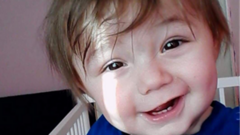Did a Grandfather Really Kill His Grandson? He Claims He Never Laid a Hand on Him

## Understanding the Legal and Emotional Implications of Child Abuse Cases
In recent years, the tragic stories surrounding child abuse have gained heightened attention, bringing to light the complexities of familial relationships and legal accountability. One such case that has captured public interest is that of Michael Ives, who stands accused of murdering his two-year-old grandson, Ethan Ives-Griffiths. This case raises several crucial questions about the nature of child abuse, the dynamics of parental behavior, and the legal ramifications that ensue when a child's life is tragically cut short.
### The Incident: A Brief Overview
Ethan Ives-Griffiths suffered a catastrophic brain injury on August 16, 2021, while at his grandparents' home. The circumstances surrounding his death are shrouded in allegations of child abuse and negligence. Both his grandfather, Michael Ives, and grandmother, Kerry Ives, along with his mother, Shannon Ives, face serious charges including murder, causing or allowing the death of a child, and cruelty to a child.
### The Court Proceedings: A Glimpse of Testimonies
During the trial at Mold Crown Court, Michael Ives took the stand and shared his perspective on familial interactions. His testimony revealed a concerning dynamic within the household, particularly focusing on Shannon's allegedly volatile temperament.
#### Key Points from Michael Ives' Testimony
- **Shannon's Temperament**: Michael described Shannon as "quick-tempered," stating she would react aggressively when Ethan misbehaved. This raises questions about the role of emotional regulation in parenting and its potential impacts on child behavior.
- **Physical Discipline**: Michael recounted instances where Shannon resorted to physical discipline, including slapping Ethan on the back of the head and delivering a "backhander to the mouth" when he exhibited behavior that displeased her. This testimony highlights the ongoing debate about the effectiveness and morality of physical discipline in child-rearing.
- **Denial of Aggression**: Notably, Michael Ives maintained that neither he nor Kerry Ives had ever physically disciplined a child. This assertion introduces a layer of complexity regarding accountability—how do we determine culpability in environments where multiple caregivers are involved?
### The Emotional and Psychological Impact on Children
The implications of such cases extend far beyond legal judgments; they delve into the emotional and psychological impact on children. Exposure to aggressive behavior, even if not directly abusive, can lead to a range of developmental issues in young children, including:
- **Increased Anxiety**: Children may develop anxiety about their safety and predictability of their environment.
- **Behavioral Issues**: Exposure to aggressive behavior can lead to increased aggression in children, as they may emulate the actions of adults.
- **Trust Issues**: A lack of a safe, supportive environment can hinder the development of trust between a child and their caregivers.
### Legal Consequences and Responsibilities
The legal system often grapples with the challenges of determining guilt in child abuse cases. The complexities of familial relationships can blur the lines of accountability. Here are some key aspects to consider:
#### Legal Definitions of Child Abuse
- **Physical Abuse**: Defined as inflicting physical harm or injury to a child. This includes actions such as hitting, slapping, or any behavior that causes physical pain.
- **Emotional Abuse**: Involves behaviors that harm a child's emotional development or sense of self-worth. This can include verbal aggression, neglect, or overly harsh criticism.
- **Neglect**: Failure to provide for a child's basic needs, whether physical, emotional, or educational.
#### The Role of the Legal System
The legal framework surrounding child abuse cases is designed to protect the vulnerable. However, it often faces criticism regarding its efficacy:
- **Burden of Proof**: In criminal cases, the prosecution must prove guilt beyond a reasonable doubt, which can be difficult in familial contexts where evidence may be scarce.
- **Sentencing and Rehabilitation**: Courts must balance the need for justice with opportunities for rehabilitation, especially in cases involving parents or guardians.
### Community and Societal Impact
The ramifications of child abuse extend into communities and society at large. Here are some important considerations:
#### Awareness and Prevention
- **Education**: Raising awareness about the signs of child abuse and the importance of healthy parenting strategies can help prevent future cases. Community programs that educate parents on effective discipline strategies and emotional regulation are crucial.
- **Support Services**: Providing accessible mental health services and support systems for families struggling with anger management or stress can mitigate the risk of abusive behavior.
#### Reporting Mechanisms
- **Mandatory Reporting**: Many jurisdictions have laws requiring certain professionals to report suspected child abuse. Strengthening these reporting mechanisms can help identify at-risk children early.
- **Community Vigilance**: Communities play a vital role in safeguarding children. Encouraging neighbors and family members to speak up when they notice concerning behavior can help protect vulnerable children.
### Conclusion
The case of Michael Ives and the tragic death of Ethan Ives-Griffiths serves as a harsh reminder of the complexities surrounding child abuse and the profound impact it can have on families and communities. Understanding the dynamics of familial relationships is crucial in addressing the underlying issues that lead to such tragedies.
As society continues to grapple with these challenges, it is essential to foster a culture of awareness, education, and support. By doing so, we can work towards preventing future incidents and ensuring the safety and well-being of all children.
What steps do you think communities can take to better protect children from abuse?
#ChildSafety #ChildAbuseAwareness #LegalResponsibility
### FAQs
What constitutes child abuse legally?
Child abuse is generally defined as any action by a caregiver that results in harm to a child, which can include physical, emotional, or sexual abuse, as well as neglect.What are the signs of child abuse?
Signs of child abuse may include unexplained injuries, changes in behavior, fear of certain adults, withdrawal from social interactions, and signs of anxiety or depression.What should you do if you suspect child abuse?
If you suspect child abuse, it is essential to report your concerns to local authorities or child protective services. They have the resources and authority to investigate the situation appropriately.Published: 2025-06-30 13:14:11 | Category: wales



